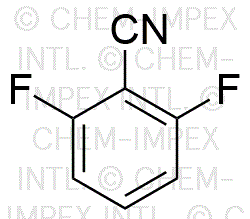2,6-Difluorobenzonitrile is widely utilized in research focused on:
- Pharmaceutical Development: This compound serves as an important intermediate in the synthesis of various pharmaceuticals, particularly in the development of anti-inflammatory and anti-cancer drugs.
- Agricultural Chemicals: It is used in the formulation of agrochemicals, including herbicides and pesticides, enhancing crop protection and yield.
- Material Science: The compound is employed in the production of specialty polymers and resins, which are crucial for creating durable materials used in coatings and adhesives.
- Research and Development: It acts as a building block in organic synthesis, enabling researchers to explore new chemical reactions and develop novel compounds.
- Fluorescent Probes: 2,6-Difluorobenzonitrile is used in creating fluorescent probes for biological imaging, aiding in the study of cellular processes.
General Information
Properties
Safety and Regulations
Applications
2,6-Difluorobenzonitrile is widely utilized in research focused on:
- Pharmaceutical Development: This compound serves as an important intermediate in the synthesis of various pharmaceuticals, particularly in the development of anti-inflammatory and anti-cancer drugs.
- Agricultural Chemicals: It is used in the formulation of agrochemicals, including herbicides and pesticides, enhancing crop protection and yield.
- Material Science: The compound is employed in the production of specialty polymers and resins, which are crucial for creating durable materials used in coatings and adhesives.
- Research and Development: It acts as a building block in organic synthesis, enabling researchers to explore new chemical reactions and develop novel compounds.
- Fluorescent Probes: 2,6-Difluorobenzonitrile is used in creating fluorescent probes for biological imaging, aiding in the study of cellular processes.
Documents
Safety Data Sheets (SDS)
The SDS provides comprehensive safety information on handling, storage, and disposal of the product.
Product Specification (PS)
The PS provides a comprehensive breakdown of the product’s properties, including chemical composition, physical state, purity, and storage requirements. It also details acceptable quality ranges and the product's intended applications.
Certificates of Analysis (COA)
Search for Certificates of Analysis (COA) by entering the products Lot Number. Lot and Batch Numbers can be found on a product’s label following the words ‘Lot’ or ‘Batch’.
Numéro de catalogue
Numéro de lot/série
Certificates Of Origin (COO)
This COO confirms the country where the product was manufactured, and also details the materials and components used in it and whether it is derived from natural, synthetic, or other specific sources. This certificate may be required for customs, trade, and regulatory compliance.
Numéro de catalogue
Numéro de lot/série
Safety Data Sheets (SDS)
The SDS provides comprehensive safety information on handling, storage, and disposal of the product.
DownloadProduct Specification (PS)
The PS provides a comprehensive breakdown of the product’s properties, including chemical composition, physical state, purity, and storage requirements. It also details acceptable quality ranges and the product's intended applications.
DownloadCertificates of Analysis (COA)
Search for Certificates of Analysis (COA) by entering the products Lot Number. Lot and Batch Numbers can be found on a product’s label following the words ‘Lot’ or ‘Batch’.
Numéro de catalogue
Numéro de lot/série
Certificates Of Origin (COO)
This COO confirms the country where the product was manufactured, and also details the materials and components used in it and whether it is derived from natural, synthetic, or other specific sources. This certificate may be required for customs, trade, and regulatory compliance.


